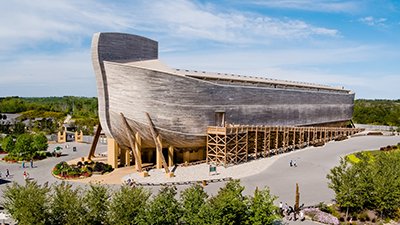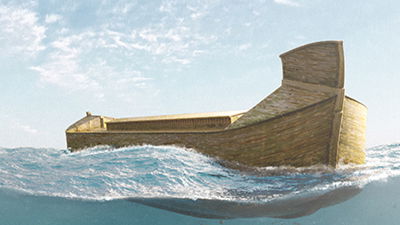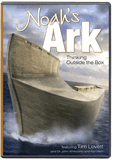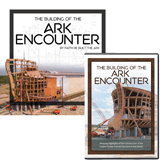Feedback: Are Wooden Ships Reliable?
Part 2
Tim Lovett continues his examination of wooden shipbuilding in response to a blogger.
Last week we started to examine a blog post titled “More Lies from Ken Ham” that appeared as a May 12 posting on “The Bushy Tree” website, by a blogger labeled as “Froggie.” This blogger wrote a scathing commentary on a Noah’s Ark article written by Tim Chaffey regarding AiG’s latest project, the Ark Encounter—a full-size Noah’s Ark to be built south of Cincinnati, Ohio. In reply to “Froggie,” Tim Lovett, who is the primary consultant for Ark theory and design on the Ark Encounter project, is responding to these criticisms of our article. We encourage you to read last week’s article, “Could Noah’s Ark Float Without Problems? Part One.”
Anyone who has ever built a wooden boat of any length knows very well that they are impossible to seal 100%.
That’s a sweeping statement. Planked wooden boats are prone to leakage if they flex with slip, but a rigid vessel (e.g., cold molded) can be sealed and made watertight. The Bible specifies that Noah used pitch, just like wooden ships from ancient times to the 1900s. In addition, Noah was instructed to use pitch inside as well as out, which may have been to stabilize the wood over a long construction period.
The wood will also expand and contract, further opening the thousands of seams/ joints.
Wood expands when wet and contracts when dry. If a pitched joint allowed water to seep into the wood, the resulting expansion of the planks acts to seal the faulty joint tight. The expansion of moist wood counteracts the opening of seams and joints, and the wood will not contract again until the Ark is sitting on dry ground, after it’s all over.
Wooden ships were routinely built on land and then sent down the slipway into the water without a problem. To top this, the ancient Greeks seemed quite capable of taking their triremes in and out of the water—drawing them up onto the beach to prevent waterlogging and keep them lightweight.1
The Ark started out on dry land. With enough water pouring in from “somewhere,” to cover the earth in 40 days indicates ridiculously large waves/ currents/ swells further complicating the idea of a large wooden vessel. After all, creationists claim that all the billions of metric tons of sediment in the geologic column were laid down by the flood, which would take extraordinary flows of water.
That “somewhere” water is ocean water where much originated in the springs of the great deep. AiG favors the tectonic plate Flood model as a flood mechanism, as you can read yourself on the AiG website (“Catastrophic Plate Tectonics: A Global Flood Model of Earth History” and “Can Catastrophic Plate Tectonics Explain Flood Geology?”)!
According to Dr. John Baumgardner—a world expert in computer modeling of the earth’s mantle and leading proponent of the tectonic mechanism for the global Flood—the initial inundation would be very severe, subsiding somewhat by the time the waters reached a higher altitude Ark launch site.2 This would explain why all other ships were destroyed, since they started at sea level.
Once afloat, the average depth of water of almost two miles (three km)3 would have shielded the Ark from tectonic activity. Deep water is safe in a tsunami.4 The Ark had to survive the ocean surface, not the massive sediment flows at and near the seabed.
Ironically, such large-scale currents are essential if you want to explain the formation of transcontinental sedimentary layers that lack the telltale signs of weathering and erosion between them you’d expect with big time gaps. Without a catastrophic flood there are many loose ends to tie up: fossils of sea creatures high above sea level, rapid burial of plants and animals, and sediments carried long distances. The global Flood is a much better match for what we find in the geological record.
Occam’s Razor, anyone?
Comparing the Ark to Other Ships
The Ark’s dimensions were supposedly 135 meters long, 22.5 meters wide, and 13.5 meters high. That’s 450 feet long, 75 feet wide, and 45 feet high.
Close enough if you were using the short cubit, but if you glanced at the AiG’s website, you’ll find a slightly different cubit.
The largest “wooden” ship ever built, that actually sailed was the Pretoria at 103 m long (338 ft.) and 13.4 m wide (44 ft.) and 23 feet high. She was a barge built for use on the Great Lakes.
A Great Lakes barge? So you conveniently cherry-picked a barge that lasted 5 years while a 1909 wooden schooner of similar length (Wyoming) lasted 15 years, and paid for itself many times over. Another ship of Pretorian length was the 1853 clipper Great Republic, which survived a fire and lasted another nineteen years. These ships were commercial workhorses built as quickly as possible and with an expected working life of only 12–15 years or as little as ten.5 ,6 Yes, they leaked excessively as the hull worked loose because the stiffness of the hull depended almost entirely on the tightness of caulking. Even placing two pins in each plank gave little improvement.7
She had a wooden frame but it was reinforced with Keelson Plates, chords, arches and was diagonally strapped with steel. It leaked so badly that it took 2 dedicated engines to keep the water pumped out of the interior. She leaked like a sieve.
Steel (well, iron actually) is not the only way to brace a wooden ship. House framing needs bracing, too, and this can be done either by steel straps or plywood sheathing.
Look at the carvel planking technique that dominated wooden shipbuilding in the last few centuries.
Now let’s look at the carvel planking technique that dominated wooden shipbuilding in the last few centuries.8 The method was simple and quick, but prone to racking because the parallel planks were “nailed” to parallel frames.9 The only bracing was the caulking itself, so a new ship didn’t stay a “tight ship” for very long. Larger ships were subject to higher forces, which sped up the loosening of the caulked planks, leading to reinforcement by means of iron straps. These diagonal straps certainly helped improve a bad design and gave the single layer of carvel planking some much-needed shear resistance. But the steel straps were pinned (bolted) to softer wooden frames, a considerable stress concentration especially at the ends of the straps.
This led to the next patch-up: steel plates at the top and bottom to secure the diagonal bracing. Okay, that kept the hull sides intact, but now the problem was transmitted to the top deck.10
Later, during World War I, steel was scarce and wooden supply ships were being built in a hurry.11 Naval architects revisiting the carvel hull bending problem made big increases to keelson depth and upper deck reinforcement (using clamp and shelf strakes).12 ,13 One design aimed to “produce a boat which will have strength equivalent to that of a steel hull without using excessive amounts of timber.”14 It had a double layer of diagonal planking under the standard planks. That’s not a carvel hull, that’s cold molded, just like the wooden minesweepers built in the 1990s.15
So the short-comings of a carvel hull are not easily corrected. The better way is to use a planking method with inherent shear strength, akin to a house frame braced with plywood instead of clapboards (also called lap siding or weatherboards).
The Pretoria was built by James Davidson, the preeminent marine engineer of his day. She was launched in July of 1900 and sank in rough weather on lake Michigan in September of 1905, partly due to the Pony Engines failing and the ship filled with water.
Only steel reinforcement allowed the Pretoria to sail, but in 1869 Britain built the largest true wooden ship, the HMS Orlando. She was 335 feet long. She suffered from the strain of her length creating massive leaks and was scrapped in 1871 after a few short voyages.
Sorry, there’s an HMS Orlando (1858-1871) made of wood with iron bracing or a later HMS Orlando (1886-1905) with an iron hull. Read the PBS website.16 So I am helping you with your argument, even the 1858 Orlando had iron bracing (although you did try to cut its lifespan down from 13 years to 2).
It is easy to cherry-pick poor performers—Pretoria and Orlando—because these ships were based on carvel hull anyway, built like a “bundle of reeds.” There are much better ways to build a wooden ship.
Another consideration is that the modern wooden ships were far more stable in moderate to high seas due to the fact that they were Keel ships by construction and they were powered, and ‘V’ shaped, which enabled them to “cut through” the waves.
Since you mention “Keel ships” and “V” shapes, you might be referring to deadrise—a “V” shaped bottom—something that has been around since antiquity. Most modern ships have a flat bottom (no deadrise) amidships, which is stable too and increases carrying capacity.
Or perhaps by “V” shaped you mean a pointed bow in conjunction with a prominent keel, improving directional stability when the vessel is making way. Indeed, that can be read on the AiG website too.
The Ark, being a straight sided box would have been at the mercy of even moderate or light seas with waves and wind smashing against the straight sides.
Keel ships, with their attendant ribs are intrinsically stronger and triangulated frame rather than a box ship with corners that would increase longitudinal torque.
A straight-sided box with corners? Anyone claiming to “peruse” the AiG website on a weekly basis would quickly find a ship-like Ark with three keels (see “Thinking Outside the Box” for example).
It is also interesting to note that Noah had no engines to pump out water from the interior of the ark and with eight people aboard, it is absurd to think that they bailed it by hand.
Yes, I agree that your idea of hand-bailing is absurd. Power for winching or pumping can come from other sources, like wave motion, wind, or animal draft power.
Finally, Johan Huibers from the Netherlands has built a 1/2 scale ark.
No, he also built a full-scale Ark. Initially he built a half-scale Ark (in 2007)—you can read about it on the AiG website. In 2012, Johan completed his second Ark, this time at full-scale. You can read about it on the AiG website News to Note, December 15, 2012 and Noah’s Ark in the Netherlands!
Even though it has steel reinforcement, it was considered unseaworthy and was installed on barges and towed via some canals to the port of Rotterdam where it is on display.
No, this is misleading (i.e., obfuscation). It was not a wooden vessel but a clapboard (weatherboard) superstructure that was purpose-built on steel barges as an Ark look-a-like (albeit lapstrake or clinker built). Johan’s first Ark was a great demonstration of what one man can do (in two years, I might add), but it is a themed attraction, not a ship-proving test.
Not that a half-scale Ark needs any proof: 225 feet (69 m) was a typical size for a large wooden ship. It is not a great deal longer than the world’s oldest wooden ship still afloat, the USS Constitution (1797). There is no steel reinforcing in “Old Ironsides,” despite the nick-name.
But anyway, your comment about a half-sized Ark needing steel reinforcement is invalid.
Come back next week for my response to the claim that Noah’s Ark was unseaworthy as I finish my analysis of this critique of our article.
With regards,
Tim
Footnotes
- Lionel Casson, Ships and Seamanship in the Ancient World (Baltimore, MD: The Johns Hopkins University Press, 1995), p. 89. “Every effort was made to keep the hull as light as it could possibly be; . . . Precautions were constantly taken to see that waterlogging did not add unwanted weight.”
- A higher altitude launch would protect the Ark from the violence of the initial inflows of ocean water.
- “Ocean Facts: Did you know?” http://www.ocean-expeditions.com/ocean-facts/. “If all the land in the world was flattened out, the Earth would be a smooth sphere completely covered by a continuous layer of seawater 2,686 metres [over a mile] deep.”
- “What You Should Do,” National Weather Service, http://www.nws.noaa.gov/om/brochures/tsunami6.htm. “If there is time to move your boat or ship from port to deep water . . . .”
- George C. V. Holmes. 1906, Ancient and Modern Ships. Part 1. Wooden Sailing Ships, http://www.gutenberg.org/files/33098/33098-h/33098-h.htm. Referring to ships in the early 1800s in England, Holmes writes, “It had been felt for many years that the system of building was very defective, and the life of a man-of-war was consequently short, only fifteen years for a ship built of English oak in the Royal dockyards, and about twelve years for similar vessels built in private yards. Amongst the greatest defects was the absence of longitudinal strength to enable a ship to resist the effects of hogging and sagging strains in a sea-way.”
- Tyrone G. Martin, A Most Fortunate Ship: A Narrative History of “Old Ironsides” (Annapolis, MD: Naval Institute Press, 1997), p. 193. “USS Constitution (1797) was built in an era when a wooden ship had an expected service life of ten to fifteen years.”
- H. R. Milner and J. Peczkis, “Wooden Ship Hulls as Box Girders with Multiple Interlayer Slip,” Journal of Structural Engineering 133, no. 6 (June 2007): 855–861. “In frame-built construction, there is usually no direct lateral plank-to-plank connection: There is only the friction provided by the oakum rammed between the planks . . . even carvel construction that employs two rows of densely spaced fasteners (instead of the usual single row) fails to achieve complete composite action.”
- A carvel hull is formed by parallel horizontal planking fixed to parallel vertical frames (usually by spikes, trunnels, or bolts) to form a smooth outer surface. Lengthwise joints between the planks are typically caulked with fiber and sealed.
- D. L. Dennis, The deficiencies of wooden shipbuilding (London, UK: Mariner’s Mirror, 1964), pp. 50, 62–63.
- H. R. Milner and J. Peczkis, “Wooden Ship Hulls as Box Girders with Multiple Interlayer Slip,” p. 859. “. . . the asymmetric cross section of traditionally built wooden hulls, in which too much timber is already situated in the sides and bottom, and not enough in the deck ‘flange.’”
- Harvey Cole Estep, How Wooden Ships Are Built: A Practical Treatise on Modern American Wooden Ship Construction with a Supplement on Laying Off Wooden Vessels (Cleveland, OH: The Penton Publishing Co., 1918).
- Ibid., figure 36, 37.
- Ibid., p. 6.
- Ibid., figure 40.
- The last Avenger-class wooden minesweeper was commissioned in 1994. The 224-foot (68 m) hull was framed in wood and planked with diagonal layers of fir, then covered with fiberglass. Wood was used to minimize the magnetic signature of the vessel. USS Guardian (MCM-5), launched in 1987, and ran aground near the Philippines on Tubbataha Reef on 17 January 2013. The hull was holed but remained intact for months before being cut into three sections and lifted off the reef by crane ships by March 30, 2013.
- “Asia’s Undersea Archeology,” NOVA Online, http://www.pbs.org/wgbh/nova/sultan/archeology2.html. “Both the Mersey-class frigates and the largest of the wooden battleships, the 121-gun Victoria class, required internal iron strapping to support the hull.” Cf. Richard A. Gould, Archeology and the Social History of Ships (New York, NY: Cambridge University Press, 2000).
Recommended Resources

Answers in Genesis is an apologetics ministry, dedicated to helping Christians defend their faith and proclaim the good news of Jesus Christ.
- Customer Service 800.778.3390
- © 2025 Answers in Genesis






